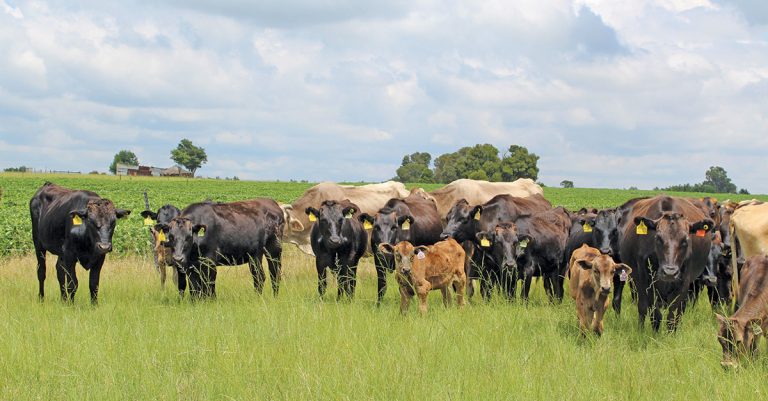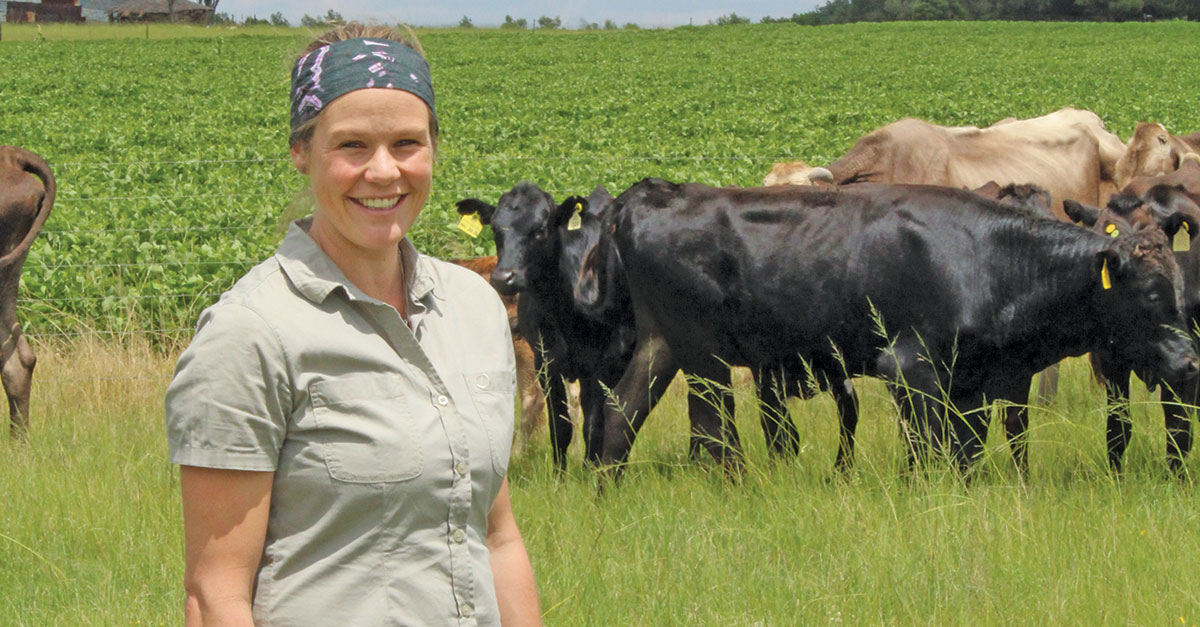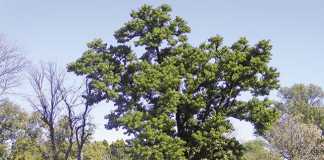
Photo: Lindi Botha
Dr Anja Steinberg, a full-time veterinarian, has always had an eye for opportunity. Taking note of increasing talk about the sought-after meat qualities of the Wagyu beef breed, she and her husband bought their first Wagyu cow in 2015.
Steinberg began doing embryo flushing, combining it with bought-in semen and using surrogate dams from the commercial herd of various breeds on her family farm in Hendrina, Mpumalanga.
She focuses on seedstock production and producing purebred, top-quality Wagyu stud animals. Her clients consist of commercial beef farmers who want to increase marbling in their meat by crossbreeding their animals with the Wagyu.

While her husband runs a commercial Beefmaster herd and stud, a commercial sheep flock, and a maize and soya bean enterprise, the Mooiplaats stud is Steinberg’s business.
“I have a passion for Wagyu; they’re lovely to work with due to their placid temperament,” she says.
Improving genetics
Steinberg is working towards improving both milk and meat qualities in her herd.
“Wagyus are known for their meat quality and marbling, but their milk production is rather low, which can make rearing calves trickier. This is why I select for strong milk qualities.
“I also aim to increase meat quality and marbling, as that’s where the value lies in the breed. It’s a balancing act to ensure they have enough milk to raise their young, as well as meat quality good enough to ensure that a commercial beef farmer will want the genetics to obtain good marbling in his or her meat production.
“Unfortunately, genetics work in such a way that if you select stringently for one quality, you end up forgoing another. It’s rare to get an animal that has perfect qualities all round.”
Embryo flushing has advanced Steinberg’s herd fairly quickly; it has taken her just over five years to build up the herd to 60 animals. “I buy in good semen and perform artificial insemination [AI] on my cows. I buy semen from various breeders, mostly those who buy in from abroad.”
Caring for calves
Steinberg says the Wagyu breed is particularly fertile and the heifers have a high conception rate.
“I try to breed at about 24 months to give them a chance to grow a bit more so that they’re fully grown when they calve. If you let them calve earlier, all of their energy goes into their calves and they never reach their full growth potential. If they’re fully grown, they don’t struggle to calve either, and their intercalving period [ICP] is shorter.”
The breeding cycle starts in October for the heifers and November for the cows. The process begins when the animals are divided into groups according to size, age, and which bull they will be mated with.
The animals receive Multimin to provide them with extra trace elements, such as zinc and copper, and Ocean Gold, which prevents vitamin A deficiency.
“Once all their vaccinations are up to date, we start with the AI process and then put the female animals into a camp with a follow-up bull. We have an 80% to 90% success rate with AI, with the last round being 100% successful.”
It is important not to handle the female animals in the first 14 days after the AI has been done.
“It takes about seven days for the embryo to implant, and during this time [the female animal’s] stress levels must be minimised, as cortisol can cause the embryo not to implant. This is why we do all vaccinations before the breeding cycle, and also ensure they remain in the same herd that they were grouped into at the start of the season. There’s a natural hierarchy in each herd and if you mix [the animals] they get stressed, and this can influence conception rates.”
Steinberg’s herd has an average ICP of 365 days. Calves weigh between 25kg and 28kg at birth, which is small when compared with other breeds, but standard for purebred Wagyu.
“Wagyu calves are strong when they’re born, but grow more slowly than other breeds. If I can get them to 18 months, they’re good to go, but before that they need to be coddled a bit. I keep them in camps close to the house so I can walk through the herd every morning and keep an eye on them.
“You can’t just leave the cows to calve in the veld and expect to return to find healthy mothers and progeny a few weeks later. You need to make sure the calves get enough colostrum and milk. This means the cows need to be in good condition when they calve, as this will ensure that their milk is adequate.”
The cattle are raised on sourveld, and calves are given creep feed when they are still suckling.
“I give them a boost with additional feed when they’re weaned, because their weight tends to drop drastically when they go onto veld. Once their weight has stabilised, they graze on the sourveld.
“They wean at about 170kg, and our weaning percentage is in the high 90s. It’s a valuable breed and we have good genetics, so it’s important to go the extra mile to ensure that the herd is strong and healthy.”
The cattle are placed in camps to graze, and receive protein and phosphate licks in winter and summer respectively. The sourveld camps average 2ha, with the veld providing a carrying capacity of 4 MLU/ha.
The right marbling
The value of Wagyu meat lies in the marbling score given to each piece of meat. Marbling
is graded from 1 to 9+, with 1 being the lowest level of marbling and 9+ the highest. The South African Wagyu Society uses a carcass camera to grade the marbling, which provides an objective score. Steinberg aims for a marbling score of between 4 and 7, which is based on local demand.
Her long-term plan is to cover the entire value chain.
“I want to crossbreed with the Beefmasters and take them right through to slaughter, grade the meat using the carcass cameras, and then package and sell it under our label.
“We have crossbred a few animals already, but I still want to perfect my genetics and the breeding process to get the correct marbling.”
Wagyus are generally sent to slaughter at approximately three years of age.
“This is about a year later than most other breeds, since you need to feed Wagyus slowly and over a longer period to maximise the marbling. If they get too fat too quickly, you end up with one thick layer of fat on the outside, instead of the fine lines of fat within the muscle that result in succulent meat.”
For this reason, she notes, it is not the ideal breed to send to a feedlot.
“The feedlot’s aim is to feed the cattle as little and as quickly as possible to achieve a
good-sized carcass for slaughter. Wagyus would have been bought in at a premium to begin with and would then need a slow and steady approach to feeding. If the animal doesn’t have good genetics and the carcass doesn’t have a high enough marbling score, the feedlot would have lost out.
“It’s risky for them because they don’t know if they’ll get a return on their investment. So it’s important to build a relationship with feedlots and prove the worth of your genetics so they know what they’re buying.”
Email Dr Anja Steinberg at [email protected].













